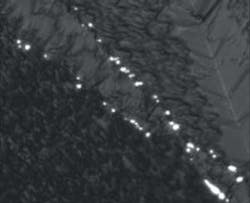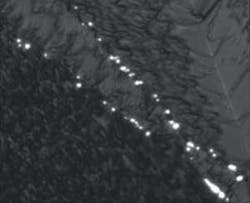Putting solar cells in reverse highlights their defects
Researchers at the University of Leipzig (Leipzig, Germany) and Q-Cells (Bitterfeld-Wolfen, Germany) have come up with a new way to test multicrystalline solar cells to optoelectronically find their defective areas with unprecedented resolution. The method highlights defects particularly on the cell’s grain boundaries. One previously known way to test solar cells is to feed an external electrical current into the cell in the direction of the cell’s forward bias; the current causes the cell to produce IR light in the same way as an LED. Defective areas immediately show up as dark regions; these are the same regions that would not efficiently collect solar energy. However, this test is not very spatially accurate.
Instead, Dominik Lausch of the University of Leipzig fed current into solar cells in the opposite direction (the reverse-bias direction), getting a very different result. In this case, only the defects themselves emitted light, and did so very brightly indeed at the boundaries of the cell’s multicrystalline grains. This test is an important one, because when part of a solar cell is subjected to a shadow in operation (due to a falling leaf, for example), that portion of the cell switches from forward to reverse bias; localized defects in the cell can then cause a strong current to flow that could wreck the cell. Contact [email protected].

